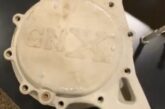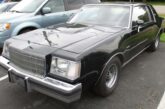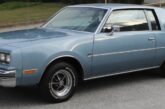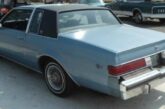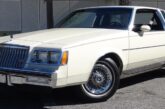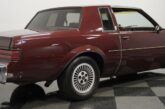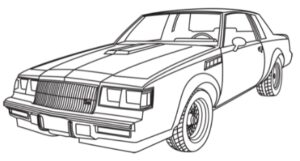In 1984, Buick finally put the key elements of its two racing programs together to produce an exciting new Grand National Regal for full production.
This helped drive all Regal Turbo V6 sales up even further, with a total of 5,401 turbocharged V6 Regals being sold. Two thousand of these carried that first specifically offered Grand National package, with the remaining 3,401 being T-Types.
It appears that Buick took the turbocharged 1982 Grand National Sport Coupe, added fuel injection, a lot of black paint and chrome-plated wheels, and came up with a car that initiated a following among a group of car enthusiasts that became truly remarkable.
In fact, it can be said that the Buick Grand National revived the term “Muscle Car”, brought this aging concept forward into the eighties, and has kept it alive ever since. When it came along the Grand National was an exceptionally strong-performing, yet very comfortable large American coupe in the tradition of the late ’60’s muscle cars. Actually, it still fits this description.
It may come as a surprise to many of the Grand National and other Turbo Regal enthusiasts today that neither of the racing success stories at Buick that spawned the Grand National had anything to do with organized drag racing. But equally interesting is that it was the Grand National’s prowess at drag strips across the US that eventually propelled this automobile into the lofty position it occupies today.
The first racing success story behind the Grand National began with that Turbocharged Century Indy Pace Car in 1976. The company’s development efforts with the turbocharged V6 in this car were so successful that Buick was able to put this engine into a production car in 1978, the Regal Turbo Sport Coupe. Buick continued the development of this wonderful engine until it became competitive at the highest levels of American racing at that time – the Indianapolis 500. It is probably not just coincidence that Buick broke all time previous sales records in 1983 and 1984, with more than one million cars sold worldwide in ’84, then had its second best sales record in history in 1985, the year that Buick qualified for the pole position at Indianapolis.
Unfortunately, Buick’s involvement with further development of the Turbo V6 engine ceased with the end of production of the Buick Grand National in December of 1987.
Fortunately, after-market builders and developers continued to build upon the base engine design primarily by designing and producing add-on performance parts.
And the Grand National’s status, along with its other Turbo Regal stable mates, continued to grow into their present legendary proportions.
For its part, Buick continued to improve the basic design of its subsequent normally aspirated 3.8 Liter engine (some with a supercharger), until its capability and reliability became so obvious that it was adopted by other divisions of General Motors as their “corporate engine”, the GM 3800 Series engines.
A number of variations of the 3.8 liter V6 were made over the years, including the 3.0 Liter in some of the early 80s front wheel drive cars, the 4.1 Liter used in some of the larger rear wheel drive cars, and of course, the Turbo 3.8L variations used in the mid-sized Regals beginning with the Regal Sport Coupes in 1978 through the last Regal Grand Nationals in 1987, in some early ’80-81 Monte Carlos, and in the Riviera S-Types and T-Types up until 1985.
The Turbo Riviera’s are an interesting story in their own right with some of the best-built and more rare cars of the Buick turbocharged V6 family. In 1984 only 1,153 Turbo Riviera’s were produced, followed by only 1,069 in 1985, the last year for the big, classic front wheel drive models that first appeared in 1979. A convertible T-Type with the Turbo V6 could be ordered in that last year and just forty-seven of them were sold, the rarest Turbo Buick after the twenty-five 1982 Grand National Sport Coupes.
The Grand Nationals and other Turbo Regals from 1984 through 1987 with on-board computer controlled sequential port fuel injection (SFI) are the most relevant Buick Turbo engines to enthusiasts today.
These are the cars that made all the noise on both the street and drag strips across America.
But, essentially, the basic design for the engine in these models didn’t change much from those in the 1978 Regal Turbo Sport Coupes until the 1987 Grand Nationals.
The blocks had slight revisions up until 1986, mainly to increase oiling and to revise the deck heights to allow the use of thicker composition head gaskets.
One of the bigger changes was in 1985 when the oil pans went to 20 bolt oil pans instead of 14 bolts.
However, it is not our intention to go into detail about the design and engineering of this magnificent engine, especially about the relatively minor changes that occurred in the production versions between 1984 and 1987.
These topics have been covered extensively in many places.
One of the best sources of ready information, especially on the 1986-1987 engine, can be found on the gnttype.org website, especially the technical articles by Ken Mosher; coverage includes pictures of engine blocks, heads, and accessories, found in the most relevant models.
Summary
The forgoing demonstrates that there was a profusion of Buick vehicles that were produced with the 3.8L Turbocharged V6 beginning in 1978 and continuing through the end of production of the Grand Nationals in 1987 (about 145,000).
The stated reasons for discontinuing the highly successful Regal Grand Nationals and the Turbo V6 was that Buick had committed to an all front wheel drive line-up in 1988 and there was no front transaxle around that could handle the torque and power of the Turbo motor.
The Pontiac Motor Division, however, did have such a platform with their trustworthy rear wheel drive Trans Am. A deal was stuck that allowed Pontiac to “borrow” the 3.8L Turbo for their 1989 Indy Pace Car, and the 1,555 limited production run of the 1989 Pontiac Turbo Trans Am (TTA).
This, and a few 1981 Chevrolet Monte Carlos were the only General Motors vehicles that were produced with an available 3.8L Buick Turbo V6 engine, other than the numerous Buick models reviewed above.
The Buick vehicles that were produced with this engine are summarized in the following Table.
Epilogue
We discovered a number of surprising things in our review of the lengthy history of Buick.
These include the fact that Buick was the progenitor of General Motors itself, that GM would probably not exist today but for Buick, and that Buick went through several periods where it faltered so badly that it came close to closing. But the company always came back strongly.
In fact, at the turn of the 1940’s Buick was so much stronger than other GM divisions that some thought it would take over all of GM.
The major lesson, though, was that Buick’s resurgences were always coincident with making better performing cars than their competitors were making – both internal and external to GM.
Another revelation was how important organized racing was to Buick and its cars.
Racing shaped the history of Buick from its beginnings right up to the development of the Grand National.
Most interesting was how the Grand National’s concept evolved out of two entirely different racing enterprises: Buick’s developmental engine work for its Indy cars, and the company’s success in NASCAR stock car racing.
Most surprising was that the Grand National did not spring out of any great corporate interest in organized drag racing. Certainly, the GN’s reputation with the public was built at least in part from its successes in drag racing but its renowned and well-deserved capabilities in that arena did not come about from related corporate goals.
The key point is, however, that the company was involved in organized racing at the highest levels and this had a great influence on the performance of the cars that it was selling to the public.
The corporate vision and commitment that this required paid off handsomely in sales.
There must be a lesson here for Buick and GM today.
Finally, the significance of this historical perspective of Buick performance automobiles relates not only to understanding how the Buick Turbo Regals came about, but to questions regarding which of them remain very attractive to a significant segment of the public, and have held their value in the free market compared to other vehicles of the same period.
In other words, of the many Buick models that were produced with the 3.8L Turbo V6 engine between 1978 and 1987 that are reviewed in this article, which vehicles should be able to be registered as collector vehicles on GNregistry.org? Our decision on that question is provided by the six categories of cars listed on the Registration page.
We now wait to see how the Buick Turbo V6 enthusiasts respond to this effort both by registering their vehicles, and by their comments.
.


















